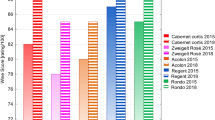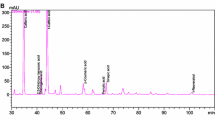Abstract
In this study, we evaluated the effect of addition of non-volatile compounds (sodium sulfite, tartaric acid, tannin, and glucose) on the rheological properties, release of aroma compounds, and color of the red wine. While determining the rheological properties of the supplemented samples, non-Newtonian fluidic and shear-thinning behavior of samples was noticed. The viscosity of these samples was found in negative correlation with the dose of addition of various non-volatile substances. The aroma profile of red wine after additions showed the change in the release of the nine key aroma compounds. Among them ethyl hexanoate, phenylethyl alcohol, octanoic acid, diethyl succinate, and ethyl octanoate were profoundly increased. Further, the color of red wines was improved in the presence of tartaric acid and tannin. Overall, supplementation of various substances during storage period of three different wines could enormously affect the sensory characteristics in a dose dependent manner.



Similar content being viewed by others
References
Arcari SG, Caliari V, Sganzerla M, Godoy HT. Volatile composition of Merlot red wine and its contribution to the aroma: optimization and validation of analytical method. Talanta. 174: 752–766 (2017)
Bautista-ortín AB, Martínez-cutillas A, Ros-garcía JM, López-Roca JM, Gómez-Plaza E. Improving colour extraction and stability in red wines: the use of maceration enzymes and enological tannins. Int. J. Food Sci. Technol. 40: 867–878 (2005)
Bindon KA, Mccarthy MG, Smith PA. Development of wine colour and non-bleachable pigments during the fermentation and ageing of (Vitis vinifera L. Cv.) Cabernet Sauvignon wines differing in anthocyanin and tannin concentration. LWT Food Sci. Technol. 59: 923–932 (2014)
Cappello MS, Zapparoli G, Logrieco A, Bartowsky EJ. Linking wine lactic acid bacteria diversity with wine aroma and flavour. Int. J. Food Microbiol. 243: 16–27 (2017)
Cesa S, Carradori S, Bellagamba G, Locatelli M, Casadei MA, Masci A, Paolicelli P. Evaluation of processing effects on anthocyanin content and color modifications of blueberry (Vaccinium spp.) extracts: Comparison between HPLC-DAD and CIELAB analyses. Food Chem. 232: 114–123 (2017)
Czibulya Z, Horváth I, Kollár L, Nikfardjam MP, Kunsági-Máté S. The effect of temperature, pH, and ionic strength on color stability of red wine. Tetrahedron. 71: 3027–3031 (2015)
De Castilhos MBM, Betiol LFL, De Carvalho GR, Telis-Romero J. Experimental study of physical and rheological properties of grape juice using different temperatures and concentrations. Part II: Merlot. Food Res. Int. 105: 905–912 (2018)
D’Onofrio C, Matarese F, Cuzzola A. Effect of methyl jasmonate on the aroma of Sangiovese grapes and wines. Food Chem. 242: 352–361 (2018)
Fracassetti D, Lawrence N, Tredoux AGJ, Tirelli A, Nieuwoudt HH, Toit WJD. Quantification of glutathione, catechin and caffeic acid in grape juice and wine by a novel ultra-performance liquid chromatography method. Food Chem. 128:1136–1142 (2011)
Friedman M. Antibacterial, antiviral, and antifungal properties of wines and winery byproducts in relation to their flavonoid content. J. Agric. Food Chem. 62: 6025–6042 (2014)
Gomez BJ, Delgado GMM, Martin DJ. Study of the acidification of sherry musts with gypsum and tartaric acid. Am. J. Enol. Vitic. 44: 400–404 (1993)
Greyling A, Bruno RM, Draijer R, Mulder T, Thijssen DHJ, Taddei S, Virdis A, Ghiadoni L. Effects of wine and grape polyphenols on blood pressure, endothelial function and sympathetic nervous system activity in treated hypertensive subjects. J. Funct. Foods. 27: 448–460 (2016)
Guan YG, Zhu SM, Yu SJ, Xu XB, Shi WH. SO32− effects the 5-hydroxymethyl-2-furaldehyde content in ammonium sulphite–glucose solutions. Int. J. Food Sci. Technol. 46: 1007–1013 (2011)
Isaac A, Livingstone C, Wain AJ, Compton RG, Davis J. Electroanalytical methods for the determination of sulfite in food and beverages. TrAC Trends Anal. Chem. 25: 589–598 (2006)
Kosmerl T, Abramoviè H, Klofutar C, The rheological properties of Slovenian wines. J. Food Eng. 46: 165–171 (2000) (in Slovenian)
Laguna L, Sarkar A, Bryant MG, Beadlingc AR, Bartoloméa B, Moreno-Arribas MV. Exploring mouthfeel in model wines: Sensory-to-instrumental approaches. Food Res. Int. 102: 478–486 (2017)
Liu HB, Mccarthy B, Chen T, Guo S, Song XG. The Chinese wine market: a market segmentation study. Asia Pac. J. Mark. Log. 26: 450–471 (2014)
Neto FS, de Castilhos MB, Telis VR, Telis-Romero J. Effect of ethanol, dry extract and reducing sugars on density and viscosity of Brazilian red wines. J. Sci. Food Agric. 95: 1421–1427 (2015)
Ni ZJ, Ma WP, Wang H, Song CB, Thakur K, Zhang H, Wei ZJ. Stability of health-promoting bioactives and enzymes in skin and pulp of grape during storage. Curr. Top. Nutraceutical Res. 15: 103–110 (2017)
Nicolli KP, Biasoto ACT, Souza-Silva ÉA, Guerra CC, Dos Santos HP, Welke JE, Zini CA. Sensory, olfactometry and comprehensive two-dimensional gas chromatography analyses as appropriate tools to characterize the effects of vine management on wine aroma. Food Chem. 234: 103–117 (2017)
Pardo-garcía AI, De La Hoz KS, Zalacain A, Alonso GL, Salinas MR. Effect of vine foliar treatments on the varietal aroma of Monastrell wines. Food Chem. 163: 258–266 (2014)
Picariello L, Gambuti A, Picariello B, Picariello L. Evolution of pigments, tannins and acetaldehyde during forced oxidation of red wine: Effect of tannins addition. LWT Food Sci. Technol. 77: 370–375 (2016)
Rodríguez-Bencomo JJ, Muñoz-González C, Andújar-Ortiz I, Martín-Álvarez P J, Moreno-Arribas MV, Pozo-Bayón MA. Assessment of the effect of the non-volatile wine matrix on the volatility of typical wine aroma compounds by headspace solid phase microextraction/gas chromatography analysis. J. Sci. Food Agric. 91: 2484–2494 (2011)
Sáenz-navajas MP, Tao YS, Dizy M, Ferreira V, Fernández-zurbano P. Relationship between nonvolatile composition and sensory properties of premium Spanish red wines and their correlation to quality perception. J. Agric. Food Chem. 58: 12407–12416 (2010)
Sagratini G, Maggi F, Caprioli G, Cristalli G, Ricciutelli M, Torregiani E, Vittori S. Comparative study of aroma profile and phenolic content of Montepulciano monovarietal red wines from the Marches and Abruzzo regions of Italy using HS-SPME–GC–MS and HPLC–MS. Food Chem. 132: 1592–1599 (2012)
Sánchez-Palomo E, Trujillo M, Ruiz AG, Viñas MAG. Aroma profile of malbec red wines from La Mancha region: Chemical and sensory characterization. Food Res. Int. 100: 201–208 (2017)
Sekowski S, Bitiucki M, Ionov M, Zdeba M, Abdulladjanovac N, Rakhimovc R, Mavlyanovc S, Bryszewskab M, Zamaraevaa M. Influence of valoneoyl groups on the interactions between Euphorbia tannins and human serum albumin. J. Lumin. 194: 170–178 (2017)
Shi JJ, Zhang JG, Sun YH, Xu QX, Li L, Prasad C, Wei ZJ. The rheological properties of polysaccharides sequentially extracted from peony seed dreg. Int. J. Biol. Macromol. 91: 760–767 (2016)
Spricigo R, Richter C, Leimkühler S, Gortonb L, Schellera FW, Wollenbergera U. Sulfite biosensor based on osmium redox polymer wired sulfite oxidase. Colloid Surf. A. 354: 314–319 (2010)
Tauchen J, Marsik P, Kvasnicova M, Maghradze D, Kokoska L, Vanek T, Landa P. In vitro antioxidant activity and phenolic composition of Georgian, Central and West European wines. J. Food Compos. Anal. 4: 113–121 (2015)
Trávníček P, Burg P, Krakowiak-Bal A, Junga P, Vítěz T, Ziemiańczyk U. Study of rheological behavior of wines. Int. Agrophys. 30: 509–518 (2016)
Vítěz T, Severa L. On the rheological characteristics of sewage sludge. Acta Univ. Agric. Silvic. Mendelianae Brun. 58: 287–294 (2010)
Yoo YJ, Prenzler PD, Saliba AJ, Ryan D. Assessment of some Australian red wines for price, phenolic content, antioxidant activity, and vintage in relation to functional food prospects. J. Food Sci. 76: 1355–1364 (2011)
Zhang QA, Wang TT. Effect of ultrasound irradiation on the evolution of color properties and major phenolic compounds in wine during storage. Food Chem. 234: 372–380 (2017)
Zhu H, Qiu J, Li ZG. Determination of rheological property and its effect on key aroma release of Shanxi aged vinegar. J. Food Sci. Technol. 53: 3304–3311(2016)
Acknowledgements
This study was supported by the Major Projects of Science and Technology in Anhui Province (17030701024, 17030701028, and 17030701058), the Breeding Program of Ningxia Agriculture (NXNYYZ20150201), and Program of Ningxia Grape and Wine innovation center.
Author information
Authors and Affiliations
Corresponding author
Ethics declarations
Conflict of interest
The authors declare no conflict of interest.
Electronic supplementary material
Below is the link to the electronic supplementary material.
Rights and permissions
About this article
Cite this article
Wang, H., Ni, ZJ., Ma, WP. et al. Effect of sodium sulfite, tartaric acid, tannin, and glucose on rheological properties, release of aroma compounds, and color characteristics of red wine. Food Sci Biotechnol 28, 395–403 (2019). https://doi.org/10.1007/s10068-018-0492-0
Received:
Revised:
Accepted:
Published:
Issue Date:
DOI: https://doi.org/10.1007/s10068-018-0492-0




